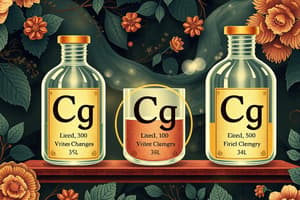Podcast
Questions and Answers
Which level of biological organization represents a group of similar cells that perform a specific function?
Which level of biological organization represents a group of similar cells that perform a specific function?
- Tissue (correct)
- Population
- Organ
- Organism
What is the scientific method's primary goal in understanding natural phenomena?
What is the scientific method's primary goal in understanding natural phenomena?
- To observe and explain natural phenomena (correct)
- To prove a hypothesis is always correct
- To create new theories
- To confirm existing theories
In the periodic table, what distinguishes an element from others?
In the periodic table, what distinguishes an element from others?
- The number of protons in its nucleus (correct)
- The mass of its atoms
- The number of neutrons in its nucleus
- The number of electrons in its outermost shell
Which of the following involves the breaking of chemical bonds and the release of energy?
Which of the following involves the breaking of chemical bonds and the release of energy?
What type of bond is responsible for the unique properties of water, such as its high boiling point and ability to dissolve many substances?
What type of bond is responsible for the unique properties of water, such as its high boiling point and ability to dissolve many substances?
What is a key characteristic of a hydrophobic molecule?
What is a key characteristic of a hydrophobic molecule?
What is the significance of carbon's 4 valence electrons for the diversity of organic molecules?
What is the significance of carbon's 4 valence electrons for the diversity of organic molecules?
Which type of isomer results from variations in the spatial arrangement of atoms around a double bond?
Which type of isomer results from variations in the spatial arrangement of atoms around a double bond?
Flashcards
Reductionism
Reductionism
Approach to understanding complex systems by breaking them down into smaller components.
Emergent Properties
Emergent Properties
Characteristics that arise from the interaction of simpler components in a system.
Autotrophs vs Heterotrophs
Autotrophs vs Heterotrophs
Organisms that produce their own food (autotrophs) versus those that consume other organisms (heterotrophs).
Binomial Nomenclature
Binomial Nomenclature
Signup and view all the flashcards
Chemical Elements
Chemical Elements
Signup and view all the flashcards
Isotopes
Isotopes
Signup and view all the flashcards
Hydrophilic vs Hydrophobic
Hydrophilic vs Hydrophobic
Signup and view all the flashcards
Valence Electrons
Valence Electrons
Signup and view all the flashcards
Study Notes
Chapter 1: Evolution, Themes of Biology, and Scientific Inquiry
- Understand reductionism and its advantages and disadvantages
- Grasp the concept of emergent properties
- Recognize the levels of biological organization
- Identify the structural parts of DNA
- Differentiate between autotrophs and heterotrophs
- Understand feedback systems and provide examples
- Recognize higher organizational level interactions and provide examples
- Formulate binomial nomenclatures correctly
- Outline the steps in the scientific method
- Develop a hypothesis based on given conditions
Chapter 2: The Chemical Context of Life
- Differentiate between elements and compounds
- Identify the components of an atom
- Interpret the periodic table, identify elements by atomic number and mass number
- Understand the effect of isotopes on atomic mass
- Explain potential energy in relation to electrons
- Interpret potential energy in relation to electron shells
- Identify polar and nonpolar covalent bonds and provide examples
Chapter 3: Water and Life
- Understand the molecular structure of water, including types of charges and bonding
- Relate kinetic energy to motion
- Differentiate between temperature and thermal energy
- Define solutions and identify components
- Differentiate between hydrophilic and hydrophobic substances and provide examples
- Calculate molecular mass of various molecules
- Understand how different ions affect pH
Chapter 4: Carbon and the Molecular Diversity of Life
- Understand the purpose of the Miller-Urey Experiment
- Identify valence electrons
- Describe carbon chains and variations
- Understand hydrocarbons
- Define isomers
- Identify constitutional (structural) isomers
- Identify cis-diastereomers (geometric isomers)
- Identify enantiomers (optical isomers)
Chapter 5: The Structure and Function of Large Biological Molecules
- Classify carbohydrates and provide examples
- Identify the forms of carbohydrates used by the body
- Differentiate between types of fatty acids
- Describe the organizational levels of protein structure and provide examples
- Compare and contrast DNA and RNA
- Predict the counter strand of a given DNA sequence
Studying That Suits You
Use AI to generate personalized quizzes and flashcards to suit your learning preferences.




